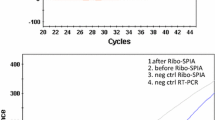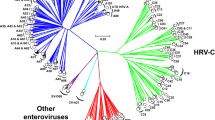Abstract
Human enteric viruses are inherently a group of viruses that confer similar or overlapping clinical symptoms and pose a challenge for correct etiological diagnosis. DNA microarray technology has emerged to be of major interest to detect broad range of viral pathogens including enteric viruses. However, this approach requires a relative large amount of target nucleic acid for hybridization analysis. This feature limits its further applicability. To address this challenge, we evaluated a novel single primer linear isothermal amplification (Ribo-SPIA) procedure for preparation of single-stranded cDNA (sscDNA) from minute amount of starting RNA for microarray-based simultaneous detection and identification of three major human enteric viruses including hepatitis A virus, norovirus, and coxsachievirus B2. We performed a series of tests using different amounts of input RNA ranging from 30 ng to 55 pg to assess amplification yield, reproducibility, analytical sensitivity, and fidelity. We demonstrated that as little as 55 pg of viral RNA could produce adequate material by Ribo-SPIA to enable successful identification by microarray analysis without compromising detection specificity. Pairwise comparison of technical replicates hybridized to the microarrays by regression analysis showed excellent reproducibility in the appropriate sensitivity range. We also showed that the use of sscDNA as labeled targets offered increased microarray detection accuracy over complementary RNA generated by traditional T7 in vitro transcription amplification method.







Similar content being viewed by others
References
Ayodeji M, Kulka M, Jackson S, Patel I, Mammel M, Cebula TA, Goswami BB (2009) A microarray based approach for the identification of common foodborne viruses. Open Virol J 3:7–20
Barker CS, Griffin C, Dolganov GM, Hanspers K, Yan JYH, Erle DJ (2005) Increase DNA microarray hybridization specificity using sscDNA targets. BMC Genomics 6:57
Bosch A (1998) Human enteric viruses in the water environment: a minireview. Internatl Microbiol 1:191–196
Brinkman N, Shay FG (2008) Development and evaluation of a generic tag array to detect and genotype noroviruses in water. J Virol Methods 156:8–18
Caretti E, Devarajan K, Coudry R, Ross E, Clapper ML, Cooper HS, Bellacosa A (2008) Comparison of RNA amplification methods and chip platforms for microarray analysis of samples processed by laser capture microdissection. J Cell Biochem 103:556–563
Chen H, Mammel M, Kulka M, Patel I, Jackson S, Biswendu B (2011) Detection and identification of common foodborne viruses with a tiling microarray. Open Virol J 5:52–59
Chen H, Wang S (2012) DNA microarray technology for the detection of foodborne viral pathogens. In: Yan X, Juneja VK, Fratamico PM, Smith JL (eds) Omics, microbial modeling, and technologies in food-borne pathogens. DEStech Publications, Lancaster, pp 579–602
Chen TC, Chen GW, Hsiung CA, Yang JY, Shih SR, Lai YK, Juang JL (2006) Combining multiplex reverse transcription-PCR and a diagnostic microarray to detect and differentiate enterovirus 71 and coxsackievirus A16. J Clin Micro 44:2212–2219
Clement-Ziza M, Gentien D, Lyonnet S, Thiery JP, Besmond C, Decraene C (2009) Evaluation of methods for amplification of picogram amounts of total RNA for whole genome expression profiling. BMC Genomics 10:246
Dafforn A, Chen P, Deng G, Herrler M, Iglehart D, Koritala S, Lato S, Pillarisetty S, Purohit R, Wang M, Wang S, Kurn N (2004) Linear mRNA amplification from as little as 5 ng total RNA for global gene expression analysis. Biotechniques 37:854–857
Eklund AC, Turner LR, Chen PC, Jensen RV, deFeo G, Kopf-Sill AR, Szallas Z (2006) Replacing cRNA targets with cDNA reduces microarray cross-hybridization. Nat Biotechnol 24:1071–73
Elnifro EM, Ashshi AM, Cooper RJ, Klapper PE (2000) Multiplex PCR: optimization and application in diagnostic virology. Clin Microbiol Rev 13:559–570
FAO/WHO [Food and Agriculture Organization of United Nations/World Health Organization]. (2007). Viruses in food: scientific advice to support risk management activities: Meeting Report. Microbiological Risk Assessment Series No. 13. Bilthoven, the Netherlands.
Farthing MJG (1989) Viruses and the gut. Smith Kline & French, Welwyn Garden City
Jaaskelainen A, Maunula L (2006) Applicability of microarray technique for the detection of noro- and astroviruses. J Virol Methods 136:210–216
Kim JM, Kim SY, Park YB, Kim HJ, Min BS, Cho JC, Yang JM, Cho YH, Ko G (2012) Simultaneous detection of major enteric viruses using a combimatrix microarray. J Microbiol 50:970–977
Kurn N, Chen P, Heath JD, Kope-sill A, Stephens KM, Wang S (2005) Novel isothermal, linear nucleic acid amplification systems for highly multiplexed applications. Clin Chem 51:1973–1981
Leski TA, Lin B, Malanoski AP, Wang Z, Long NC, Meador CE, Barrows B, Ibrahim S, Hardick JP, Aitichou M, Schnur JM, Tibbetts C, Stenger DA (2009) Testing and validation of high density resequencing microarray for broad range biothreat agents detection. PLoS One 4:e6569
Leveque N, Van Haecke A, Renois F, Boutolleau D, Talmud D, Andreoletti L (2011) Rapid virological diagnosis of central nervous system infections by use of a multiplex reverse transcription-PCR DNA microarray. J Clin Microbiol 49:3874–9
Li H, McCormac M, Estes RW, Sefers SE, Dare RK, Chappel JD, Erdman DD, Wright PF, Tang YW (2007) Simultaneous detection and high-throughput identification of a panel of RNA viruses causing respiratory tract infections. J Clin Microbiol 45:2105–9
Lung O, Fisher M, Beeston A, Hughes KB, Clavijo A, Goolia M, Pasick J, Mauro W, Deregt D (2011) Multiplex RT-PCR detection and microarray typing of vesicular disease viruses. J Virol Methods 175:236–45
Pagotto F, Corneau N, Mattison K, Bidawid S (2008) Development of a DNA microarray for the simultaneous detection and genotyping of noroviruses. J Food Protection 71:1434–1441
Rehrauer H, Aquino C, Gruissem W, Henz SR, Hilson P, Laubinger S, Naouar N, Patrignani A, Rombauts S, Shu H, Van de Peer Y, Vuylsteke M, Zeller G, Hennig L (2010) AGRONOMICS1: a new resource for Arabidopsis transcriptome profiling. Plant Physiol 152:487–499
Renois F, Talmud D, Huguenin A, Moutte L, Strady C, Cousson J, Lévêque N, Andréoletti L (2010) Rapid detection of respiratory tract viral infections and co-infections in patients with influenza-like illnesses by use of RT-PCR DNA microarray systems. J Clin Microbiol 48:3836–3842
Rzez’utka A, Cook N (2004) Survival of human enteric viruses in the environment and food. FEMS Microbiol Rev 28:441–453
Sair A, D’Souza D, Jaykus L (2002) Human enteric viruses as causes of foodborne disease. Compr Rev Food Sci Food Saf 1:73–89
Singh R, Maganti R, Jabba SV, Wang M, Deng G, Heath JD, Kurn N, Wangemann P (2004) Microarray-based comparison of three amplification methods for nanogram amounts of total RNA. Am J Physiol Cell Physiol 88:1179–1189
Acknowledgments
The excellent assistance provided by Mark Mammel is gratefully acknowledged. The authors thank Dr. Chris A Elkins for critical reading and suggestion on the manuscript. The opinions and assertions expressed here are solely those of the authors in their private capacities and do not necessarily represent the official view of the U. S. Food and Drug Administration.
Author information
Authors and Affiliations
Corresponding author
Rights and permissions
About this article
Cite this article
Chen, H., Chen, X., Hu, Y. et al. Reproducibility, fidelity, and discriminant validity of linear RNA amplification for microarray-based identification of major human enteric viruses. Appl Microbiol Biotechnol 97, 4129–4139 (2013). https://doi.org/10.1007/s00253-013-4769-1
Received:
Revised:
Accepted:
Published:
Issue Date:
DOI: https://doi.org/10.1007/s00253-013-4769-1




